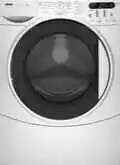KENMORE WASHING MACHINE MANUAL
Washing machines have become essential for efficient home management, and among the reliable choices available, Kenmore has consistently maintained a strong reputation. Understanding how to operate and maintain the appliance correctly ensures optimal performance and longevity. This guide provides a comprehensive overview of how to use, troubleshoot, and maintain a Kenmore washing machine efficiently.
Manual
Each model in the Kenmore series falls under the premium washing machine category. A detailed English-language user manual is available as a free PDF download, offering convenient reference and step-by-step setup guidance.
If you have questions about any of the models listed, simply navigate to the Support section in the website header. Our team typically responds within 24 hours with accurate, model-specific information.

Manual Search Method: Kenmore 41202
Control Panel and Functions
Kenmore washing machines come equipped with intuitive controls designed to simplify laundry routines. The digital display offers clear cycle selections, including Heavy Duty, Delicates, Quick Wash, and Rinse & Spin. Each function targets specific fabric types and soil levels, ensuring garments remain undamaged while receiving a thorough clean.
The cycle knob enables effortless selection, while the option buttons—such as Extra Rinse or Fabric Softener—provide customization based on the laundry load. The LED indicators guide you through every phase, from wash to spin.
Step-by-Step Operation Process
Loading the Washer:
Begin by sorting laundry by fabric type and color. Avoid overloading to prevent imbalanced spinning and reduced wash quality. Place heavier garments like towels at the bottom for better drum movement.
Selecting the Right Cycle:
Select a wash cycle based on the fabric type and the level of soiling. For instance, Normal Wash suits everyday clothes, while Heavy Duty is ideal for soiled workwear. Utilize cold water cycles for colors and delicates to preserve fabric quality and prevent fading.
Add high-efficiency (HE) detergent into the designated dispenser. Using too much detergent may lead to residue accumulation, which can gradually reduce the machine’s efficiency.
Maintenance and Cleaning
Routine maintenance significantly enhances machine lifespan and hygiene. After each use, leave the washer door open for air circulation, preventing mold or mildew formation inside the drum. Monthly drum cleaning using washer cleaner tablets or a vinegar and baking soda solution helps eliminate detergent buildup and odor.
Clean the lint filter and detergent dispenser tray regularly to avoid clogging and ensure even detergent distribution. Check the water hoses periodically for any signs of wear, such as cracks or leaks. Replacing worn-out parts promptly reduces repair costs in the long term.
Troubleshooting
Source: Bens Appliances and Junk / Youtube
Washer Not Starting:
Make sure the power cable is firmly plugged in and the washer door or lid is completely shut. Faulty lid switches or blown fuses may also hinder start-up. Reset the washer by unplugging it for one minute, then reconnecting the power.
Excessive Noise or Vibration:
Unusual sounds during spin cycles often result from unbalanced loads. Stop the cycle, rearrange the laundry for better balance, then restart the machine. Confirm the machine sits on a level surface; adjusting the feet can stabilize the washer and reduce shaking.
Water Drainage Problems:
When drainage issues occur, examine the drain hose for blockages or bends that may obstruct water flow. Cleaning the drain pump filter can also restore proper water flow. Persistent issues might require professional assistance.
Conclusion:
Maximizing the efficiency of a Kenmore washing machine involves a balance of proper operation, regular maintenance, and quick troubleshooting. Adopting these practices not only extends appliance life but also enhances daily laundry routines. Adhering to the instructions and care procedures ensures consistently clean clothing and reliable washer performance.

